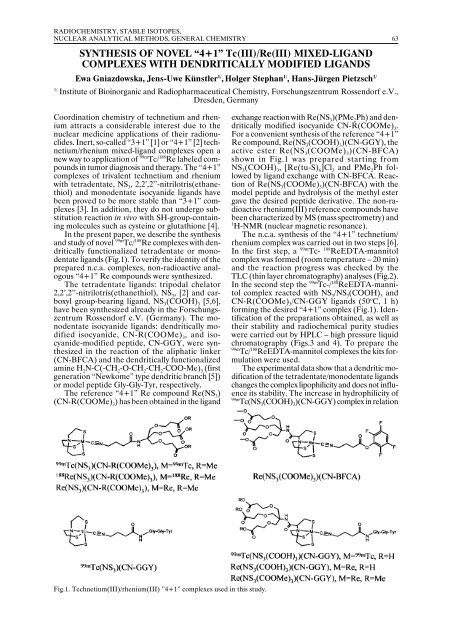annual report annual report annual report annual report 2005
annual report annual report annual report annual report 2005
annual report annual report annual report annual report 2005
Create successful ePaper yourself
Turn your PDF publications into a flip-book with our unique Google optimized e-Paper software.
RADIOCHEMISTRY, STABLE ISOTOPES,<br />
NUCLEAR ANALYTICAL METHODS, GENERAL CHEMISTRY<br />
SYNTHESIS OF NOVEL “4+1” Tc(III)/Re(III) MIXED-LIGAND<br />
COMPLEXES WITH DENDRITICALLY MODIFIED LIGANDS<br />
Ewa Gniazdowska, Jens-Uwe Künstler 1/ , Holger Stephan 1/ , Hans-Jürgen Pietzsch 1/<br />
1/<br />
Institute of Bioinorganic and Radiopharmaceutical Chemistry, Forschungszentrum Rossendorf e.V.,<br />
Dresden, Germany<br />
63<br />
Coordination chemistry of technetium and rhenium<br />
attracts a considerable interest due to the<br />
nuclear medicine applications of their radionuclides.<br />
Inert, so-called “3+1” [1] or “4+1” [2] technetium/rhenium<br />
mixed-ligand complexes open a<br />
new way to application of 99m Tc/ 188 Re labeled compounds<br />
in tumor diagnosis and therapy. The “4+1”<br />
complexes of trivalent technetium and rhenium<br />
with tetradentate, NS 3 , 2,2’,2’’-nitrilotris(ethanethiol)<br />
and monodentate isocyanide ligands have<br />
been proved to be more stable than “3+1” complexes<br />
[3]. In addition, they do not undergo substitution<br />
reaction in vivo with SH-group-containing<br />
molecules such as cysteine or glutathione [4].<br />
In the present paper, we describe the synthesis<br />
and study of novel 99m Tc/ 188 Re complexes with dendritically<br />
functionalized tetradentate or monodentate<br />
ligands (Fig.1). To verify the identity of the<br />
prepared n.c.a. complexes, non-radioactive analogous<br />
“4+1” Re compounds were synthesized.<br />
The tetradentate ligands: tripodal chelator<br />
2,2’,2’’-nitrilotris(ethanethiol), NS 3<br />
, [2] and carboxyl<br />
group-bearing ligand, NS 3 (COOH) 3 [5,6],<br />
have been synthesized already in the Forschungszentrum<br />
Rossendorf e.V. (Germany). The monodentate<br />
isocyanide ligands: dendritically modified<br />
isocyanide, CN-R(COOMe) 3 , and isocyanide-modified<br />
peptide, CN-GGY, were synthesized<br />
in the reaction of the aliphatic linker<br />
(CN-BFCA) and the dendritically functionalized<br />
amine H 2<br />
N-C(-CH 2<br />
-O-CH 2<br />
-CH 2<br />
-COO-Me) 3<br />
(first<br />
generation “Newkome” type dendritic branch [5])<br />
or model peptide Gly-Gly-Tyr, respectively.<br />
The reference “4+1” Re compound Re(NS 3<br />
)<br />
(CN-R(COOMe) 3 ) has been obtained in the ligand<br />
exchange reaction with Re(NS 3<br />
)(PMe 2<br />
Ph) and dendritically<br />
modified isocyanide CN-R(COOMe) 3 .<br />
For a convenient synthesis of the reference “4+1”<br />
Re compound, Re(NS 3<br />
(COOH) 3<br />
)(CN-GGY), the<br />
active ester Re(NS 3 (COOMe) 3 )(CN-BFCA)<br />
shown in Fig.1 was prepared starting from<br />
NS 3<br />
(COOH) 3<br />
, [Re(tu-S) 6<br />
]Cl 3<br />
and PMe 2<br />
Ph followed<br />
by ligand exchange with CN-BFCA. Reaction<br />
of Re(NS 3 (COOMe) 3 )(CN-BFCA) with the<br />
model peptide and hydrolysis of the methyl ester<br />
gave the desired peptide derivative. The non-radioactive<br />
rhenium(III) reference compounds have<br />
been characterized by MS (mass spectrometry) and<br />
1<br />
H-NMR (nuclear magnetic resonance).<br />
The n.c.a. synthesis of the “4+1” technetium/<br />
rhenium complex was carried out in two steps [6].<br />
In the first step, a 99m Tc- 188 ReEDTA-mannitol<br />
complex was formed (room temperature – 20 min)<br />
and the reaction progress was checked by the<br />
TLC (thin layer chromatography) analyses (Fig.2).<br />
In the second step the 99m Tc-/ 188 ReEDTA-mannitol<br />
complex reacted with NS 3<br />
/NS 3<br />
(COOH) 3<br />
and<br />
CN-R(COOMe) 3 /CN-GGY ligands (50 o C, 1 h)<br />
forming the desired “4+1” complex (Fig.1). Identification<br />
of the preparations obtained, as well as<br />
their stability and radiochemical purity studies<br />
were carried out by HPLC – high pressure liquid<br />
chromatography (Figs.3 and 4). To prepare the<br />
99m<br />
Tc/ 188 ReEDTA-mannitol complexes the kits formulation<br />
were used.<br />
The experimental data show that a dendritic modification<br />
of the tetradentate/monodentate ligands<br />
changes the complex lipophilicity and does not influence<br />
its stability. The increase in hydrophilicity of<br />
99m<br />
Tc(NS 3 (COOH) 3 )(CN-GGY) complex in relation<br />
Fig.1. Technetium(III)/rhenium(III) ”4+1” complexes used in this study.
















